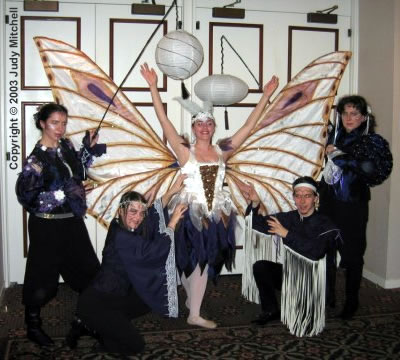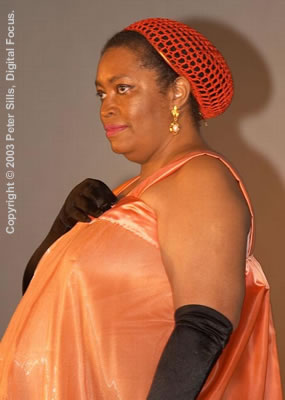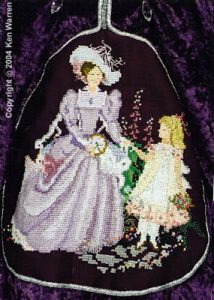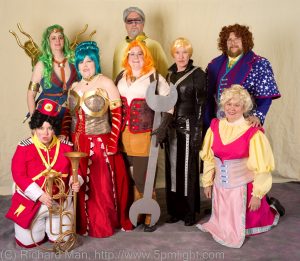CC21-SF-34b: Something New
Competition Staff & Rules
Staff:
- Director: Andrew “Don Bruce” Trembley
- Master of Ceremonies: Greg Rihn
- Workmanship Judges: Dana MacDermott*, Byron Connell, Letha Welch. Judges’ Clerks: Eileen Capes and Heather Buck
- Presentation Judge: Bruce MacDermott
Rules:
The basic information:
I’m your F&SF Masquerade director, Andy Trembley. I’m an expat Wisconsinite living in California now. I hope I can provide you a good environment to present in.
We’ve got 3 main sections here… The first explains how division placement works. The second is the rules (i.e. the things that can get you disqualified). The third is the basic briefing of what you’ve got to work with. There’s also a fourth section for your perusal, the instruction the judges will be receiving.
This is revision 1.2, published August 2002. It may not be the final revision of these docs. Please check the CC21 website (Removed) for more information.
If you have any questions, please contact me at (Removed).
Division Placement:
Most entries will be placed in the ICG standard divisions of Novice, Journeyman and Master. A group entry will be placed in the division appropriate for its most experienced member.
Master:
* Any competitor may enter in the Master division
Journeyman:
* Professional costumers may not enter in the Journeyman division.
* A contestant who has competed and won in the Master division at an international competition may not enter in the Journeyman division.”
* A contestant who has won “Best in Show” or “Best Journeyman” at an international competition may not enter in the Journeyman division.”
* A contestant who has won more than three major awards in the Journeyman division in international competition may not enter in the Journeyman division”
Novice:
* Professional costumers may not enter in the Novice division.
* A contestant who has competed and won in any division other than Novice at an international competition may not enter in the Novice division.
* A contestant who has won “Best in Show” or “Best Novice” at an international competition may not enter in the Novice division.
* A contestant who has won more than two major awards in the Novice division at international competitions may not enter in the Novice division.
For this masquerade, any person who made more than 1/3 of his or her annual income by costuming in any of the last 5 years qualifies as a “professional.” “International competition” means “World Con Masquerade or Costume-Con Fantasy and Science Fiction Masquerade.” “Major awards” includes any awards that do not feature “Honorable Mention” in the name.
Competitors under 15 who have participated in the design and creation of their costume may enter in the “Young Fan” division. Adult-designed and -constructed costumes presented by children may be entered in the maker’s division or the Exhibition division (not in competition).
Any competitor may enter in a more advanced division than he or she is placed.
Any competitor has the option to enter in the Exhibition division (not in competition).
The Rules:
You breaka da rules, you sleep wit da fishes. Barring that, you may be disqualified and dropped from the masquerade.
1. All masquerade contestants must be attending members of CC21. If the maker and presenter are different people, both must be attending members. Purchased and rented costumes may not be entered
2. A costume may not be entered in competition if it has won “Best in Show” or “Best in Division” at an ICG-.recognized international competition. It may be entered in the Exhibition division (not in competition).
3. Each presenter may only appear on stage in a single masquerade entry. One body, one presentation.
4. The standard PG rule applies. No costume is “no costume.”
5. No live animals are allowed on stage with the exceptions of a) people and b) service animals.
6. No materials or effects that will leave a mess on stage or in the green room are allowed. No effects that may ruin another entrant’s costume are allowed.
7. No pyrotechnics or any other sort of open flame[s] are allowed.
8. All special effects must be reviewed with me before or at rehearsal (again, the earlier, the better).
9. Rehearsal is required. You need it to get a feel for the stage. We need it to make sure your tech is right, and to make sure the crew knows what to expect from your entry.
10. If you’re going to have large props, bring your own ninjas to get them on and offstage. Bring them to rehearsal too.
11. Individual entries are granted 60 seconds on stage. Group entries are granted 90 seconds on stage. Additional time may be granted if you can show me that you will use it well. Requests for additional time should be made early (i.e. as soon as you know how long you want). Last-minute requests (any point after your paperwork is turned in) will not be looked upon favorably.
The hints:
We’re gonna make ya some suggestions ya can’t refuse. In other words, the following information will help you ensure you get the most out of your investment in the competition.
* This is a Fantasy and Science Fiction Masquerade. Please respect our theme. There is a Historical Masquerade for your historical costume.”
* if you think a personal or business relationship with a judge will make it difficult for the judge to be objective, please talk to me. I will consult with the judging panel, and we’ll come up with a reasonable course of action.
* If you’re entering a re-creation costume”, bring documentation. A letter-size color photocopy or color print of your source should be sufficient to show the judges what you’re trying to recreate (6 copies would be nice). The judges will probably ignore anything other than that. Video, floppy disks and CDs are right out. Paper, please.
* Workmanship judging is optional. In the F&SF masquerade”, workmanship is judged by a separate panel and has no bearing on presentation awards. All entrants are encouraged to participate in workmanship judging.
* Don’t wear your masquerade entry in the halls at the convention before the masquerade. This will reduce the impact your entry has on the judges and audience. Most judges will ding an entry they’ve seen walking around the halls.”
* Don’t plan on having access to power on stage. We don’t plan to have it. Extension cords all over the stage aren’t particularly safe.”
* Don’t plan for complex lighting. We don’t plan to have it. If you wish anything other than default lighting”, discuss it when you check in with me, and also with the crew at rehearsal.
* Don’t plan to use a microphone. During presentations”, the MC is the only person with a microphone. Spoken narrative may be pre-recorded or in the form of a script for the MC (24pt type preferred). Spoken dialog must be pre-recorded.
* Speaking of pre-recorded”, we will accept tape and CD. The “5-tape rule” is a good guideline. Terrible things can happen to tapes and CDs; make a master and 4 copies. Pack them in separate bags. I’ve seen too many people lose their only tape.
* If you are providing a CD, make sure it only includes the material you wish to use on track 1 (no commercial CDs). If you are providing a tape, same deal, and make sure your material is recorded at the start of both the A-side and B-side.
Judges’ Instructions
“Excellence deserves award” is your watchword.
I ask that you be serious in granting awards. A serious award with a funny name is fine. Please don’t grant an award if you don’t think the entry has real merit. No “joke” awards.
You are encouraged to award “Best in Show” and “Best in Division” (for each division) if you find such awards are appropriate. For all other awards, please judge each entry on its own merit.
It’s up to you to decide whether an entry deserves a major or minor award. Consider, though, that for novice and journeyman division, major awards indicate you think the entrant deserves a nudge into a more experienced division.
Please identify “minor” awards by using “Honorable Mention” in the award name. Anything that doesn’t have “Honorable Mention” in the name is a major award.
For each award granted, please identify the entry and the competitor being granted the award. For example:
* you wish to give a child a presentation award for a costume made by an adult. Name the child.”
* you wish to give a workmanship award to the person who did all the beading on a group entry. Name that person.”
If you need help identifying the appropriate person to grant an award, ask your clerk.
Competitors who have entered re-creation costumes are asked (but not required) to provide as documentation a color photocopy or print of the image the costume is based on. You may ignore any documentation beyond that.
If you think a personal or business relationship with a competitor will make it difficult to be objective in your judging, please talk to both me and your fellow judges about the problem, and we’ll come up with a reasonable course of action.




